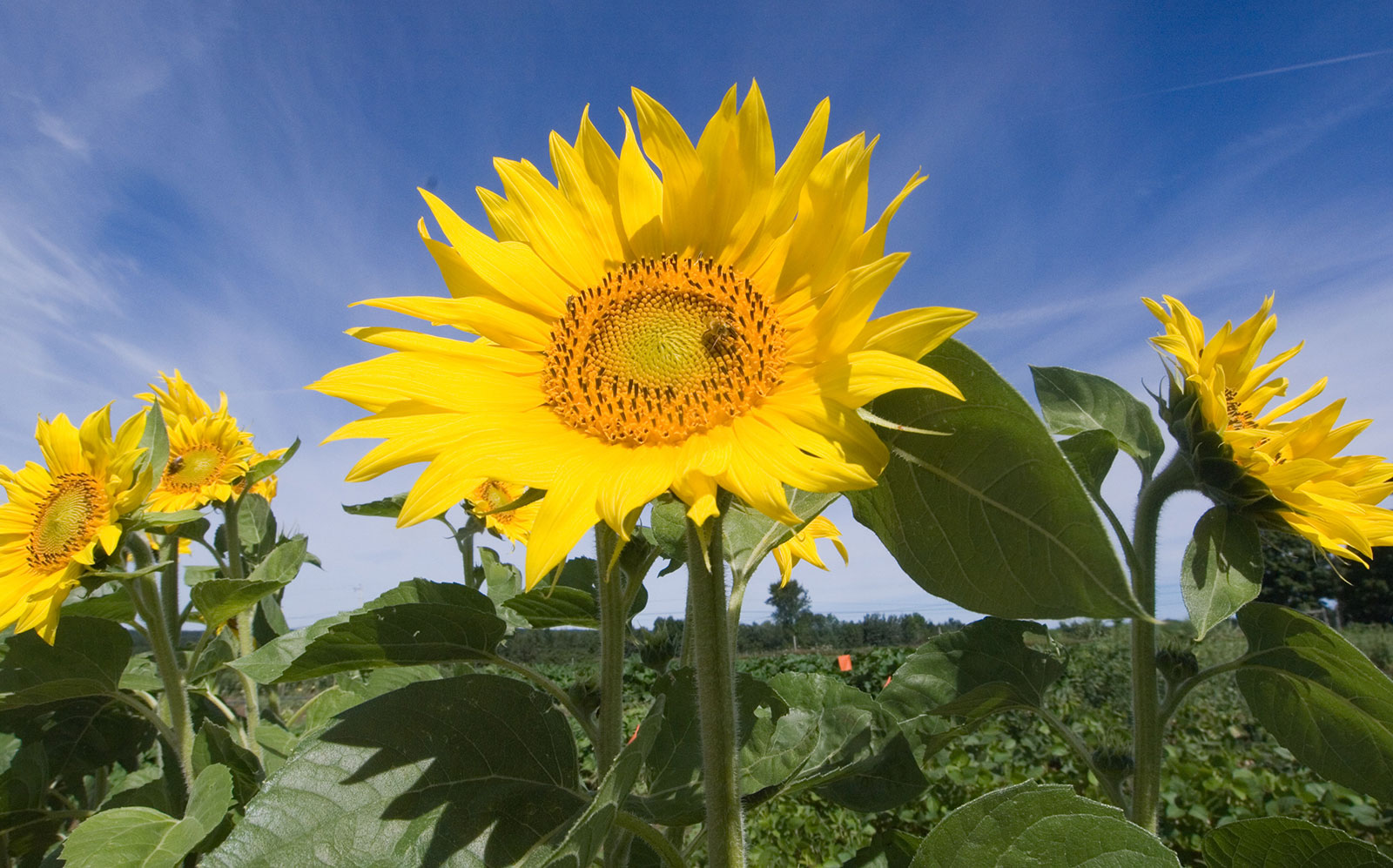
Maine Home Garden News — June 2017
- June Is the Month to . . .
- Summer’s Flowers: Sunflowers
- Understanding Weeds to Understand Weed Control
- Community Garden at the Dempsey Center for Cancer, Hope & Healing Grows!
- Food & Nutrition: Garlic Scapes and Freezing Pesto
June Is the Month to . . .
By Richard Brzozowski, Food System Program Administrator, UMaine Extension
-
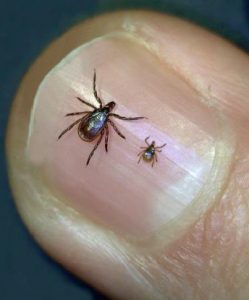
Adult and nymph deer ticks. Image by Griffin Dill. Be aware of the threat of ticks. Learn more about ticks at
- Make a short list of problems you faced last growing season with your yard, gardens, and trees. Develop a plan to address one or more of these issues this growing season with a goal of improving the situation.
- If you have space, plant additional vegetables and flowers this month. It’s still not too late to plant seedlings (transplants) of tomatoes, peppers, eggplant or to sow seeds of cucumbers, summer squash, beans, beets, carrots, etc.
- Use a liquid starter fertilizer (or starter solution) around your newly transplanted seedlings to reduce root stress and encourage new growth. These products are readily soluble and contain suitable amounts of phosphorus to encourage new root growth. Examples of such starter fertilizers have analysis such as 10-20-10 and 15-30-15. These pulverized fertilizers are typically dissolved in water at a rate of 1 tablespoon per gallon to make the solution. Approximately one cup of solution is applied around each seedling after planting. Be sure to follow all product label directions and precautions. Organic fertilizers usually have lower numbers for their analysis. For organic starter fertilizers, seek one with a 1-2-1 ratio.
- Grow some vegetables and flowers in containers. See Bulletin #2762, Growing Vegetables in Container Gardens for more information.
- Visit your favorite garden center or nursery. Seek out new and traditional plant materials as well as other garden-related products for gardening in Maine. To find a local garden center near you, visit the Plant Something Maine website.
- Continue to be prepared for possible frosts in your area in the early part of June. Be aware of weather forecasts each evening. If you use a mobile device, consider an app for warnings about frosts.
- Remove flowering stalks from your rhubarb plants. For more information, see Bulletin #2514, Growing Rhubarb in Maine.
- Harvest your asparagus. If you are considering growing asparagus, see Bulletin #2071, Growing Asparagus in Maine and our checklist for the best chance of success with your asparagus plants.
- Tell a friend or colleagues at work about the Maine Home Garden News. Current and back issues can be found at the Maine Home Garden News website. Let us know if you would like to be notified when new issues are posted. To receive e-mail notifications, fill out our online form.
- Visit a private or public garden. Most gardeners appreciate visits from other gardeners. During your visit, look for ways to improve or enhance your own garden.
- Check for insect pest damage to your plants by making “walk throughs” each week. Look for leaf, stem, and blossom damage. Check the undersides of leaves for egg masses. Make an accurate identification of the pest(s) before making any treatments. Visit UMaine Extension’s Insect Pests, Plant Diseases & Pesticide Safety website for facts sheets about common insect pests in Maine. Submit an Insect Specimen for free identification and diagnostic help.
Summer’s Flowers: Sunflowers
By Lynne Holland, Community Education Assistant, UMaine Extension Androscoggin and Sagadahoc Counties
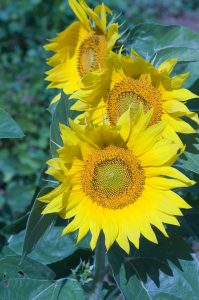 The most famous images of sunflowers are probably the series of nearly a dozen paintings by Van Gogh of various sunflowers featuring the summer beauties that, to many, symbolize summer. The sunflower is a flower with a great work ethic, not only looking good, but also tasting good and accomplishing good in its environment. It is such an important plant it even has its own association — The National Sunflower Association.
The most famous images of sunflowers are probably the series of nearly a dozen paintings by Van Gogh of various sunflowers featuring the summer beauties that, to many, symbolize summer. The sunflower is a flower with a great work ethic, not only looking good, but also tasting good and accomplishing good in its environment. It is such an important plant it even has its own association — The National Sunflower Association.
Sunflowers we see in gardens today are primarily hybridized strains of the North American native sunflower (Helianthus annuus). All parts of the sunflower plant were used by Native Americans in the Southwest for food, dye, building materials, and included in ceremonial use. Brought to Europe by the Spanish explorers by 1500, only relatively recently has it been recognized for its commercial value. Most of the hybridization to create the wide array of sizes, shapes, colors, oil content, and other features has been done in Europe. Their American origins explain many of the variety names along with the features that were focused on in the hybridization process. As a commercial crop, the seeds and the oil are both prized. In the garden, the flowers are not only attractive to the human visitors, but also appeal to bees, butterflies, and wildlife.
Sunflowers perform best in full sun and well-drained soils. They have deep and wide roots to balance out their great height, but still occasionally tip over in heavy winds and shallow soils. They are easy to plant from seed once the ground warms up to 55°F or can be transplanted as seedlings. Some varieties can grow to over 15′ tall while some branching varieties can get to be 3′ in circumference. The seed head, especially if you are growing for seed or oil, can be quite large in some varieties and can serve as great winter interest if left in the garden or tucked into outdoor container arrangements.
A single sunflower is, in fact, a collection (aka inflorescence) of very small flowers called ray and disk flowers. Ray flowers are what we typically call “petals” and the disk flowers are found in the center of the inflorescence. Look closely the next time you’re near a sunflower to find the reproductive parts on both the disk flowers — you may notice the pollen-bearing anthers and the ovary containing an ovule that, when fertilized, develops into seed. Another fun botanical feature of sunflowers is heliotropism or “following” the sun through the day. The trait is especially noticeable in larger varieties when they are just beginning to bloom.
Some fun varieties to try in Maine are:
American Giant and Mammoth Varieties produce the towering dinner plate sized sunflowers that bear a lot of seeds and make excellent cut flowers. If the plants are pinched back either intentionally or by a critter eating the top of the plant, these will also branch but the head of the flowers will be smaller.
Dwarf Sunflowers are generally less than 4’ tall. Some are even suited to container growing. A few varieties have double petals or unusual flowers. ‘Teddy Bear’ and the ‘Smiles’ series are common choices. Most of these varieties will also branch out to a certain degree.
Branching Sunflowers are generally over 4’ tall and many can tower in the 10’ range by the end of the season. There’s a lot of variety of color in this group ranging from lemony yellow to a mahogany brown. Most varieties produce many flowers per plant with 1-4’ stems. Cutting back of spent flowers will encourage new flowers to form. ‘Autumn Beauty’, ‘Ring of Fire,, ‘Moulin Rouge,’ and ‘Lemonade’ are just a few of the varieties in this group.
In 1987 Van Gogh’s painting Sunflowers in a Vase sold for over $39 million; this summer, beautiful sunflowers in your garden will be priceless.
Understanding Weeds to Understand Weed Control
By Donna Coffin, Extension Educator, UMaine Extension Piscataquis County
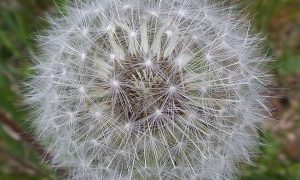 Correct identification of the problem weed gives access to information about its life cycle and, in turn, information about best methods and timing for eradication. Weed identification keys, such as this helpful ID tool from Cornell, often start off asking whether a weed is grass-like or broad leaved and then take you into more in-depth questions to narrow down the options for what you might be dealing with.
Correct identification of the problem weed gives access to information about its life cycle and, in turn, information about best methods and timing for eradication. Weed identification keys, such as this helpful ID tool from Cornell, often start off asking whether a weed is grass-like or broad leaved and then take you into more in-depth questions to narrow down the options for what you might be dealing with.
Once your weed is identified, you can determine what life cycle the plant has — annual, biennial or perennial.
- Annuals grow from seed, mature to a flowering stage, and produce seed for the next generation in one year or less. They die after a single reproductive cycle. Annuals are best controlled when they are very small seedlings, but at all costs, should be removed before they set seed. Keep in mind that some species of weeds can produce hundreds of thousands of seeds from a single plant and those seeds can remain viable in the soil for 40+ years. This is why it’s so important to reduce the weed seed “rain” each year. In urgent and overwhelming situations, simply mowing before plants develop seeds can make a significant impact on the weed seed rain.
- Biennials require two years to complete their life cycle. These plants grow from seed that germinates in the spring and develops heavy roots and compact rosettes or clusters of leaves the first summer. Biennials remain dormant through the winter, then in the second summer they mature to a point where they flower, produce seed, and die.
- Perennial plants live more than two years and may live indefinitely. Perennial plants may grow from seed, but many also produce storage structures such as bulbs, tubers, rhizomes (underground stems) or stolons (above-ground stems) from which plants can develop. Seed is the primary method of introducing these weeds to new areas; however, perennial weeds are often spread during soil preparation and cultivation.
Annuals and biennials should be controlled early in the growing season, not only to destroy plants of the current generation, but to prevent seed formation for the next. Repeated shallow cultivation of young weed plants (once a week) with a wire weeder or hoe can help gardeners keep ahead of the problem without bringing up as many weed seeds in the seed bank as they would with deep tilling. Physical suppression with mulches can also be a reasonable and effective strategy — especially around larger transplants. Biodegradable mulches include paper or cardboard topped with straw (not hay), bark mulch, or compost. Plastic or fabric mulches can be easier and faster to install, but take time and effort to remove and dispose of at the end of the season. Read more about mulches here.
Weed control practices on perennials must deal with below-ground structures as well as the above-ground portions of the plant.
In perennial weeds, the period when root reserves have been maximally depleted and carbohydrates are beginning to move back down to form new underground structures occurs when the plant has reached one-fourth of its height or is at the early flower bud stage. These are the ideal times for control measures, such as clean cultivation, close mowing or foliar applied herbicides.
Adapted from an article in the Piscataquis Gardening Newsletter, June 2010.
Other helpful resources:
- Weed Management Research at UMaine
- UMass Weed Herbarium
- Virginia Cooperative Extension — Weeds in the Home Vegetable Garden
- “In the Weeds”: UMaine graduate student Sonja Birthisel conducts weed management research to find environmentally safe practices producing maximum benefit to Maine farmers and gardeners.
Community Garden at the Dempsey Center for Cancer, Hope and Healing Grows!
By Lynne Holland, Community Education Assistant, UMaine Extension Androscoggin and Sagadahoc Counties
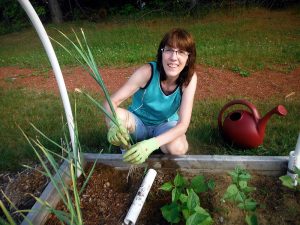
The headline is stolen, but this article is not fake news. This is an update on a project first written about in Maine Home Garden News in July 2014 by Tori Jackson. The Dempsey Center initiated a garden for hope and healing in 2013 with help from the UMaine Cooperative Extension and area partners. Like any garden, the Dempsey Garden has grown and had changes over the years. The biggest change to date started in the summer of 2016 when project partner Cascade Fiber abruptly closed and put the land and buildings the garden is situated on up for sale. The newest thing growing in the garden was uncertainty.
The garden itself had been evolving and by mid summer 2016, the Dempsey garden had grown from 5 beds to 27 raised beds in the Auburn location on Cascade’s land. It had 8 perennial berry beds including blueberry, blackberry, and raspberry. Four of its beds had been planted in ornamental gourds for the Children’s Cancer Program, as they had every year since the start. The rhubarb was resting but the potatoes and tomatoes were just ripening. Over a dozen other beds held vegetable plants for the nutrition classes at The Dempsey Center. It would be no mean feat to move this garden. Faced with the uncertainty of the land and, more importantly, in a drought year, the uncertainty of access to water, the four Master Gardener Volunteers went right to work. Dennis Connelly ’10, who heads the team of MGVs (Linda Croteau ’14, Donna Lebrun ’14, and Bonnie McLaughton ’15), got the okay from Cascades to continue to work on the land while the land was up for sale. Cascades also delivered two large tanks of water to help them finish out the season. Maintenance and harvest proceeded pretty much as normal but the monthly meetings and weekly work/harvest sessions were all focused on the next step and the uncertainty surrounding it. The garden was put to bed in the fall with no clear answers. A lot of time and effort had been invested in the garden over the years — it would be devastating to have it all be plowed under.
During the winter, The Dempsey Center began discussions with Whiting Farm in Auburn. Whiting Farm (@WhitingFarm1930), owned by John F. Murphy Homes, is a working four-season farm dedicated to community enrichment, education, and the support of people with disabilities. Whiting Farm agreed to let the Dempsey Garden move their garden over to a spot on Whiting Farm, should they need to. They would share a two-acre field with two other organizations. As winter slowed down and the first planning meetings of the season began, word came that the new owner of the Cascade’s land would not only let the garden remain there, but they too would support the garden with water each season. The Dempsey garden went from uncertainty to overabundance. A second garden was born at that meeting.
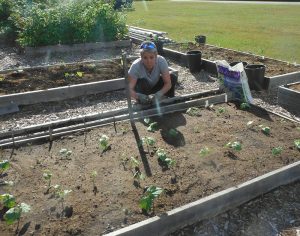
In light of the new collaboration with Whiting Farm, and with four Master Gardener Volunteers working on it, the new plan was formed. The current garden location would get a partial overhaul using the resources from a small grant that allowed the use of professional garden planning software. Linda Croteau ’14 would coordinate a new plan of the Cascade beds with the idea of crop rotation and production in mind. All the perennial fruit and herb beds would be kept but also evaluated for the future. The production focus would be fruits and vegetables to be used in the Nutrition Program Cooking Classes at the Dempsey Center as well as the classes that Master Food Preserver Dennis Connelly would teach there. The new two-acre space would be a collaborative effort by the Dempsey Center nutritionist Judy Donnelly, Dennis Connelly and his team of Master Gardener Volunteers, Kim Finerty (Whiting Farm Manager), and the Center for Wisdom’s Wisdom (from Lewiston). The first year will be focused on doing some in-ground planting as well as planning the future gardens for that space. The space would eventually be a mix of client and production raised beds, herb and flower beds for Wisdom’s Women, an outdoor meeting area, and a garden for working, walking, meditating, and fun.
The Dempsey Garden volunteers will continue to meet monthly, rotating the meeting space between the two gardens. The Master Gardener Volunteers and any interested garden volunteers will continue to meet weekly in the garden(s) where they will do that week’s work and decide the focus for the coming week in the garden. Harvest will still be done twice weekly with the Nutrition Class schedule driving that effort. Extra produce will be made available free to the families impacted by cancer who come to the Dempsey Center for support. To quote Tori Jackson in her article from 2014, “Physical exercise, fresh air, healthy food, hands-on education, and friendship are exactly the kinds of benefits the Dempsey family had in mind when they created the Center,” and now they will have two places to make that hope and healing happen.
Food & Nutrition: Garlic Scapes and Freezing Pesto
By Kate McCarty, Food Preservation Community Education Assistant, UMaine Extension Cumberland County
Growing garlic is one of the more satisfying experiences for the patient gardener. The bulbs may take about a year to form, but springtime brings another edible offshoot from the plant — garlic scapes. Hardneck garlic sends up curly stalks in the spring that should be trimmed to prevent the growth of the scape from impacting with the size of the garlic bulb.
Watch our video to learn the best way to remove garlic scapes from the plant.
If you didn’t plant garlic in your garden last fall, garlic scapes can also be found at the farmers’ market this time of year. Scapes can be used in cooking to add mild garlic flavor or made into pesto.
While we typically think of basil pesto, any herb can be used to make this paste of herbs, garlic, cheese, nuts, and oil. Garlic scapes are more mild than garlic cloves, so scapes can be used raw in pesto. To make garlic scape pesto, simply substitute chopped garlic scapes in for basil in your favorite recipe. Garlic scape pesto can be used in pasta and eggs dishes, pizza, seafood and poultry, potato salads, and even eaten as a dip.
Pesto should be stored in the refrigerator and used within three days or frozen for long term storage. To freeze pesto, fill freezer-grade plastic or glass containers and leave 1/2-inch headspace. Label and date, and use within 8-12 months for best quality. To learn more about freezing local foods, see a listing of our hands-on food preservation workshops.
For more information about growing garlic in Maine, see Growing Hardneck Garlic in Your Maine Garden and for more information about freezing, see National Center for Home Food Preservation General Information on Freezing.
University of Maine Cooperative Extension’s Maine Home Garden News is designed to equip home gardeners with practical, timely information.
Let us know if you would like to be notified when new issues are posted. To receive e-mail notifications fill out our online form.
For more information or questions, contact Kate Garland at katherine.garland@maine.edu or 1.800.287.1485 (in Maine).
Visit our Archives to see past issues.
Maine Home Garden News was created in response to a continued increase in requests for information on gardening and includes timely and seasonal tips, as well as research-based articles on all aspects of gardening. Articles are written by UMaine Extension specialists, educators, and horticulture professionals, as well as Master Gardener Volunteers from around Maine, with Katherine Garland, UMaine Extension Horticulturalist in Penobscot County, serving as editor.
Information in this publication is provided purely for educational purposes. No responsibility is assumed for any problems associated with the use of products or services mentioned. No endorsement of products or companies is intended, nor is criticism of unnamed products or companies implied.
© 2017
Call 800.287.0274 (in Maine), or 207.581.3188, for information on publications and program offerings from University of Maine Cooperative Extension, or visit extension.umaine.edu.
